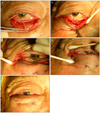Abstract
Purpose
To evaluate the effects of the modified medial spindle and the lateral tarsal strip procedure in involutional ectropion patients.
Methods
The lateral tarsal strip procedure with the modified medial spindle procedure that adjusts the size and the position of the spindle along the severity of lower eyelid eversion was performed on 17 eyes of 12 patients with involutional ectropion. The average follow-up period was 19.6 months.
Figures and Tables
Figure 1
Surgical procedures in repairing right lower eyelid involutional ectropion. (A) A diamond-shaped fusiform wedge of the conjunctiva and lower eyelid retractor was excised inferior to the lower margin of the tarsal plate, depending on the degree of lower lid eversion using Ellman Surgitron F.F.P.F®. (B) The defect of the conjunctiva was closed with a double-armed 5-0 polyglactin (Vicryl®). The 1-3 point suture depending on the size of conjunctival defect was initially passed through the retractor at the lower edge of the incision in a backhanded pass, then uniting the tarsal plate and conjunctiva on the upper edge. After both arms of the suture is pulled superiorly, joining the edge of the lower border of the incision. And then the suture is passed full-thickness through the eyelid. (C) The cantholysis was performed using Ellman Surgitron F.F.P.F®, releasing lower eyelid completely from its attachment to the lateral canthal tendon, and the periosteum of the lateral orbital wall was exposed. (D) The tarsal strip was sutured to the periosteum on the inner aspect of the lateral orbital wall with double-armed 5-0 polyglactin (Vicryl®). (E) the suture tension was adjusted as needed to invert the lower lid margin to the proper position, the suture was tied on the skin surface.

References
1. Collin JRO. A Manual of Systematic Eyelid Surgery. 1989. 2nd ed. Edinburgh: Churchill Livingstone;27–40.
2. Levine MR. Manual of Oculoplastic Surgery. 2010. 4th ed. Thorofare, NJ: SLACK;173–182.
3. Bashour M, Harvey J. Cause of involutional ectropion and entropion - age-related tarsal changes are key. Ophthal Plast Reconstr Surg. 2000. 16:131–141.
4. Smith B. The "lazy-T" correction of ectropion of the lower punctum. Arch Ophthalmol. 1976. 94:1149–1150.
5. Della Rocca DA. The lateral tarsal strip: illustrated pearls. Facial Plast Surg. 2007. 23:200–202.
6. Anderson RL, Gordy DD. The tarsal strip procedure. Arch Ophthalmol. 1979. 97:2192–2196.
7. Stefanyszyn MA, Hidavat AA, Flanagan JC. The histopathology of involutional ectropion. Ophthalmology. 1985. 92:120–127.
8. O'Donnell B. Age-related medial entropion of the lower eyelid. Aust N Z J Ophthalmol. 1994. 22:183–186.
9. Fong KC, Mavrikakis I, Sagili S, Malhotra R. Correction of involutional lower eyelid medial ectropion with transconjunctival approach retractor plication and lateral tarsal strip. Acta Ophthalmol Scand. 2006. 84:246–249.
10. White WL, Woog JJ. Albert DM, Jacobiec FA, editors. Lower eyelid malpositions. Principles and Practice of Ophthalmology [book on CD-ROM]. 1995. 49. Philadelphia: WB Saunders;596–693.
11. Wright KA. Congenital eyelid anomalies, eyelid malpositions, and blepharoptosis. Interactive ophthalmology on CD-ROM-textbook and review. 1997. Baltimore: Williams & Wilkins;5191–5326.
12. Nerad JA. Nerad JA, editor. The diagnosis and treatment of ectropion. Oculoplastic Surgery. The Requisites in Ophthalmology. 2001. St. Louis: Mosby;71–88.
13. Wesley RE. McCord CD, editor. Ectropion repair. Oculoplastic Surgery. 1995. 3rd ed. New York: Raven;249–261.
14. Putterman AM. Ectropion of the lower eyelid secondary to Muller's muscle-capsulopalpebral fascia detachment. Am J Ophthalmol. 1978. 85:814–817.
15. Wesley RE. Tarsal ectropion from the detachment of the lower lid retractor. Am J Ophthalmol. 1982. 93:491–495.
16. Nowinski TS, Anderson RL. The medial spindle procedure for involutional medial ectropion. Arch Ophthalmol. 1985. 103:1750–1753.
17. Tse DT, Kronish JW, Buus D. Surgical correction of lower eyelid tarsal ectropion by reinsertion of the retractors. Arch Ophthalmol. 1991. 109:427–431.
18. Shah-Desai S, Collin R. Role of the lower lid retractors in involutional ectropion repair. Orbit. 2001. 20:81–86.
19. Frueh BR, Schoengarth LD. Evaluation and treatment of the patient with ectropion. Ophthalmology. 1982. 89:1049–1054.




 PDF
PDF ePub
ePub Citation
Citation Print
Print



 XML Download
XML Download